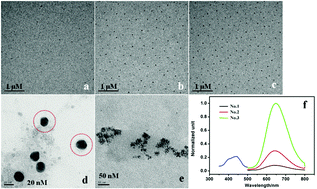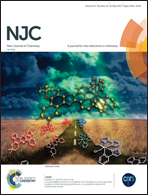Synthesis and properties enhancement of metal nanoclusters templated on a biological molecule/ionic liquids complex†
Abstract
In this study, two biological template molecules and two common short-chain imidazolium ionic liquids with amphipathy were selected to synthesize four different types of metal nanoclusters (MNCs), which were templated on a biological molecule/imidazolium ionic liquids (ILs) complex with properties enhancement. The fluorescence intensity and stability of the MNCs were improved in different degrees via this simple and fast protocol. The fluorescence intensity of AgNCs was significantly enhanced primarily due to aggregation-induced emission (AIE), and it was attributed to the shrinking size and donation of delocalized electrons for other MNCs. Different template molecule must match with appropriate ILs to form a steady complex that stabilizes the MNCs. The stability of the MNCs was improved, especially for AuNCs, because biological molecule/imidazolium ILs complex was found to be an effective barrier in protecting the MNCs from quenching interactions. Compared to conventional cationic surfactant (sodium dodecyl sulfate, SDS), these imidazolium ILs exhibited superior properties enhancement of the nanomaterials. MNCs with excellent properties could be applied in bioanalysis, especially in fluorescence imaging in vitro, because of their undisturbed and durable optical signal.



 Please wait while we load your content...
Please wait while we load your content...